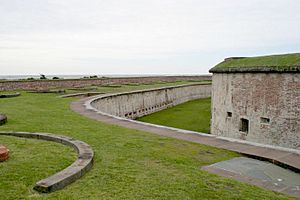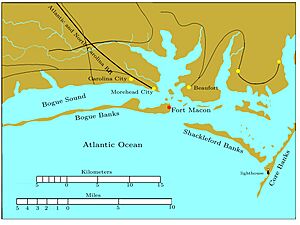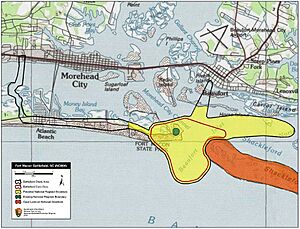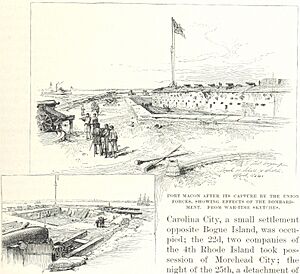Siege of Fort Macon facts for kids
Quick facts for kids Siege of Fort Macon |
|||||||
|---|---|---|---|---|---|---|---|
| Part of the American Civil War | |||||||
 Fort Macon, NC |
|||||||
|
|||||||
| Belligerents | |||||||
| Commanders and leaders | |||||||
| Units involved | |||||||
| 3rd Division, Department of North Carolina North Atlantic Blockading Squadron |
Fort Macon Garrison | ||||||
| Strength | |||||||
| 3,259 total 2,649 present for duty |
450 total 263 ready for duty |
||||||
| Casualties and losses | |||||||
| 2 killed 5 wounded 8 captured |
8 killed 16 wounded ~400 captured |
||||||
The Siege of Fort Macon was a battle during the American Civil War. It happened from March 23 to April 26, 1862. The fight took place on the Outer Banks of Carteret County, North Carolina.
This siege was part of a bigger plan by Union Army General Ambrose Burnside. His plan was called the Burnside's North Carolina Expedition. The goal was to take control of important areas in North Carolina.
In late March, General Burnside's army moved towards Fort Macon. This fort was made of stone and had strong walls. It guarded the entrance to Beaufort. Union forces surrounded the fort and began to dig trenches. On April 25, they started firing cannons at the fort. Their shots were very accurate. The fort's stone walls soon began to break apart.
By late afternoon, the fort's outer wall was collapsing. The Confederate commander, Colonel Moses J. White, decided to surrender. He raised a white flag. General Burnside's terms for surrender were accepted. Union troops took over the fort the next morning.
Contents
About Fort Macon
Fort Macon was one of many forts built along the U.S. coast. These forts were part of the "Third System" of defense. They were built after the War of 1812 to protect America's harbors. Fort Macon was built on the eastern end of Bogue Banks. This spot was chosen to protect the ports of Beaufort and Morehead City.
Construction of the fort started in 1826 and finished in 1834. It was made of strong stone and brick. At that time, cannons on ships were not very accurate. They could not easily break down thick stone walls. However, new types of cannons called "rifled artillery" were invented. These new cannons could fire much more accurately and powerfully. Fort Macon was never updated to defend against them. This meant the fort was outdated when the Civil War began.
Over the years, the fort was not well cared for. Wood rotted, iron rusted, and gun parts decayed. The number of soldiers guarding the fort became very small. By the start of the Civil War, only one sergeant was looking after it.
North Carolina troops took control of the fort on April 14, 1861. This was before the state officially left the Union. At that time, only four cannons were ready to fire. Local military leaders quickly worked to add more weapons. They mounted 56 cannons in total. But they only had enough ammunition for three days of fighting.
During the siege, about 430 officers and men were in the fort. Colonel Moses J. White was their leader. Many soldiers were sick, so only about two-thirds were ready to fight. Soldiers faced poor food and living conditions. Their spirits were low because they were far from their families. Colonel White was also not very popular. A few soldiers even ran away during the siege.
When the battle came, Fort Macon was old and not ready for the fight. It did not have enough weapons or supplies. These problems helped explain why the fort fell so quickly.
Before the Siege Began
Union forces had already captured Hatteras Island on the Outer Banks. After this, General Ambrose Burnside planned to take more of eastern North Carolina. He wanted to use both the Army and Navy for this. His plan was approved by the main Union general, George B. McClellan.
Burnside was given permission to create a special group of soldiers. This group was called the Coast Division. They would work with the Navy's North Atlantic Blockading Squadron. Their goal was to control the North Carolina Sounds and nearby cities.
This expedition, named after Burnside, started in January 1862. In early February, they won their first big battle at Roanoke Island. After that, they won more battles at Elizabeth City and New Bern. Most Confederate soldiers were pushed far inland by these victories. The only major group left near the coast was the soldiers at Fort Macon.
Fort Macon was still held by the Confederates. This meant General Burnside could not use the important ports at Beaufort and Morehead City. So, after capturing New Bern on March 14, he ordered Brigadier General John Parke to take the fort.
General Parke started by capturing towns along the inner coast. He took Carolina City on March 21, Morehead City on March 22, and Newport on March 23. Finally, he took Beaufort on March 25. This cut off Fort Macon from other Confederate forces. Parke also had to fix a railroad bridge at Newport. The Confederates had burned it when they retreated. The railroad was needed to bring heavy cannons for the siege.
The Siege Begins
On March 23, General Parke sent a message to Colonel White. He demanded that Fort Macon surrender. Parke offered to let the Confederate soldiers go home if the fort was handed over safely. Colonel White quickly replied, "I have the honor to decline evacuating Fort Macon." This exchange marked the start of the siege.
The Union forces still needed to completely surround the fort. They did this on March 29. A group of soldiers from Parke's brigade crossed the water and landed on Bogue Banks. No Confederate soldiers were there to stop them. The Confederate soldiers who should have been defending that area had left after the Battle of New Bern.
Union siege cannons were then brought in. General Parke set up four groups of cannons to fire at the fort. These cannons were hidden behind sand dunes. The Confederate soldiers in the fort knew what was happening. But they could not waste their limited ammunition by firing at targets they could not see. Small groups of soldiers sent out from the fort to bother the Union troops were pushed back. On April 17, General Burnside reported that he expected to take the fort within ten days. His prediction was very accurate.
The Bombardment
All preparations were finished by April 23. That day, General Burnside again asked Colonel White to surrender. He offered the same terms: let the soldiers go home. Colonel White refused once more. So, on April 24, Burnside ordered General Parke to start firing as soon as possible. Parke waited until nightfall to uncover his cannons behind the dunes.
The attack began at dawn on April 25. At first, the Confederate gunners in the fort fired back strongly. But they could not hit the Union cannons, which were hidden by the dunes.
The Confederate defenders also saw four Union Navy ships arrive. These ships were the USS Daylight, State of Georgia, Chippewa, and Gemsbok. Until this point, the Navy had not been part of the siege. But Commander Samuel Lockwood heard the gunfire and brought his ships into action. However, the weather was bad for naval bombardment. Strong winds made the ships rock too much, making it hard to aim. After about an hour, the ships pulled back. The Navy also sent two floating gun platforms. But again, waves made it hard to use them. Only one got into action. It is not clear if the fort was hit by any of the ships. The Confederate fire did hit two Union ships, but caused little damage and only slightly wounded one sailor.
The first shots from the Union cannons on shore were not accurate. But a Signal Corps officer in Beaufort, Lieutenant William J. Andrews, helped. He sent messages to the cannon commanders telling them how to adjust their aim. After noon, almost every shot hit the target. Nineteen of the fort's cannons were knocked out. The fort's walls began to crumble under the constant pounding.
In the middle of the afternoon, Colonel White worried that the fort's gunpowder storage (the magazine) would be hit. At 4:30 p.m., he decided the fort could not hold out any longer. He ordered a white flag to be raised. All firing then stopped.
Colonel White met with General Parke to talk about surrender terms. Parke first demanded that the fort surrender without any conditions. White asked for better terms. He reminded Parke of the terms General Burnside had offered earlier. Parke did not agree right away. He said he would talk to Burnside first. Burnside thought that White could probably hold out for another day. But more fighting would only cause more deaths and damage the fort further. So, he agreed to his original terms.
The soldiers in the fort were allowed to give their "paroles." This meant they promised not to fight against the United States again until they were officially exchanged for Union prisoners. They were then allowed to go home, taking their personal belongings. Shortly after dawn on April 26, the Confederate flag was lowered. The Confederate soldiers marched out, and Union soldiers from the 5th Rhode Island marched in.
What Happened Next
This battle did not cause many deaths, especially compared to later Civil War battles. On the Union side, only one soldier was killed. Two soldiers and one sailor were wounded. On the Confederate side, seven soldiers were killed right away. Two more died later from their wounds, and sixteen were wounded.
The Burnside Expedition had been very successful in North Carolina with few losses. However, not much was done to use these victories. For example, Wilmington, another important city, seemed vulnerable. But it was not attacked until the very end of the war. General Burnside was called away soon after the victory at Fort Macon. He went to help General George B. McClellan in the Peninsula Campaign in Virginia. No other major attacks happened in North Carolina for a long time. The state became less important in the war until much later.
The Confederate flag from Fort Macon was returned to North Carolina in 1906. This happened in a ceremony in the Senate Chamber. Veterans who fought in the siege were there. Today, the battle site is a state park called Fort Macon State Park.




